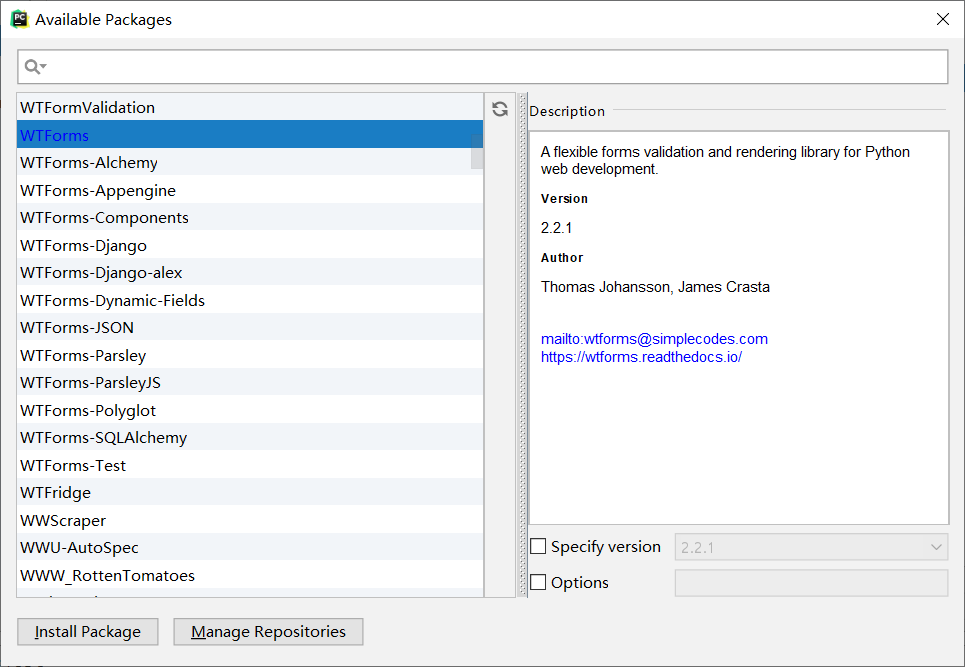一.概述
django中的forms组件非常的方便,在flask中有WTForms的组件实现的也是类似的功能, 安装这个插件

二.简单使用
文档地址https://wtforms.readthedocs.io/en/latest/
简单写一个注册的form
# 注册表单 class RegForm(Form): username = simple.StringField( label='用户名', validators=[validators.DataRequired(message='用户名不能为空')] ) password = simple.PasswordField( label='密码', validators=[ validators.DataRequired(message='密码不能为空'), validators.Length(min=1, max=10, message='密码长度不正确'), ] ) re_password = simple.PasswordField( label='确认密码', validators=[ validators.EqualTo('password', message='密码不一致') ] ) email = simple.StringField( label='邮箱', validators=[ validators.Email(message='邮箱格式不正确') ] ) hobby = core.SelectMultipleField( label='爱好', choices=[ (1, '足球'), (2, '篮球'), (3, '网球'), ], default=[1, 3], # 设置默认值, coerce=int ) gender = core.SelectField( label='性别', choices=[ (1, '男'), (2, '女') ], default=1, coerce=int ) sub = simple.SubmitField( label='提交', render_kw={'style': "color: red"}, )
这里写了sub按钮,在前端文件中如果不想让标签显示出来比如
前端页面可以这样写
<form action="" method="post" novalidate> {% for field in form_obj %} {% if field.type == "SubmitField" %} <p>{{ field }}{{ field.errors.0 }}</p> {% else %} <p>{{ field.label }}{{ field }}{{ field.errors.0 }}</p> {% endif %} {% endfor %} </form>
结果预览:

三 . 自定义验证器 validator
有两种写法,一种是类的,另外一种是写成函数
1.函数
class SignupForm(Form): age = IntegerField(u'Age') def validate_age(form, field): if field.data < 13: raise ValidationError("We're sorry, you must be 13 or older to register")
2. 类
# 自定义验证器,类 的写法 class pwd_validator(): def __init__(self, message=None): self.message = message def __call__(self, form, field): pwd = field.data if pwd != '123': raise ValidationError(self.message)
示例 登陆:
# 自定义验证器,类 的写法 class pwd_validator(): def __init__(self, message=None): self.message = message def __call__(self, form, field): pwd = field.data if pwd != '123': raise ValidationError(self.message) class LoginForm(Form): username = simple.StringField( label='用户名', validators=[validators.DataRequired(message='用户名不能为空'), ] ) # 自定义验证器, 函数的写法 def validate_username(form, field): if field.data != 'tom': raise ValidationError('用户名错误') password = simple.PasswordField( label='密码', validators=[ validators.DataRequired(message='密码不能为空'), validators.Length(min=1, max=10, message='密码长度不正确'), pwd_validator('密码必须是123'), ] ) sub = simple.SubmitField( label='登陆', render_kw={'class': 'red'} )
cbv中运用
class Login(views.MethodView): def get(self): form_obj = LoginForm() return render_template("login.html", form_obj=form_obj) def post(self): dic = request.form.to_dict() username = dic.get('username') password = dic.get('password')
# if username == 'tom' and password == '123': login_data = LoginForm(request.form) if login_data.validate(): # print(login_data.data) session['user'] = dic['username'] s = session.get('user') return '登陆成功 session是{}'.format(s) else: return render_template('login.html', form_obj=login_data)
